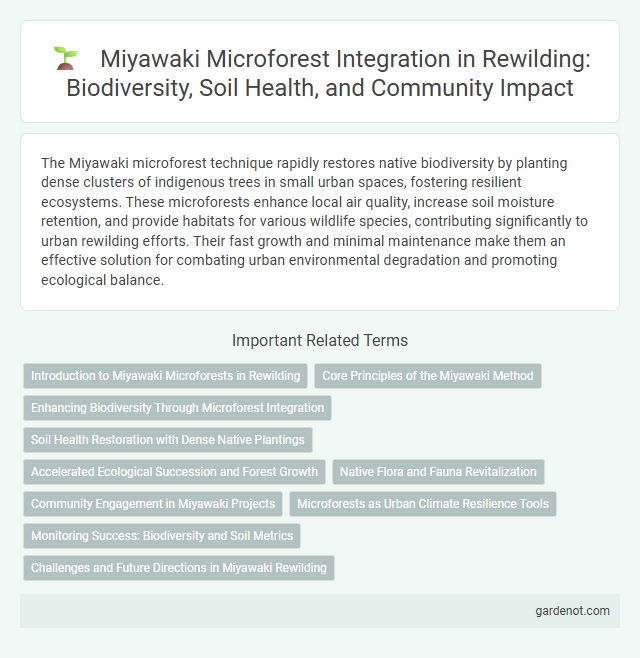The Miyawaki microforest technique rapidly restores native biodiversity by planting dense clusters of indigenous trees in small urban spaces, fostering resilient ecosystems. These microforests enhance local air quality, increase soil moisture retention, and provide habitats for various wildlife species, contributing significantly to urban rewilding efforts. Their fast growth and minimal maintenance make them an effective solution for combating urban environmental degradation and promoting ecological balance.
Introduction to Miyawaki Microforests in Rewilding
Miyawaki microforests employ native species to rapidly restore dense, biodiverse forests in small urban spaces, typically yielding full canopy cover within 20-30 years. This rewilding technique accelerates natural succession by planting multiple layers of native trees, shrubs, and ground covers that support local wildlife and enhance ecosystem resilience. These microforests improve air quality, increase carbon sequestration, and mitigate urban heat islands while fostering community engagement in ecological restoration.
Core Principles of the Miyawaki Method
The Miyawaki Method emphasizes planting native species densely to recreate natural forests quickly, enhancing biodiversity and ecosystem resilience. It involves selecting indigenous plants suited to local climate and soil conditions, promoting self-sustaining growth with minimal maintenance. This approach accelerates rewilding by restoring ecological balance and fostering habitat complexity in urban and degraded landscapes.
Enhancing Biodiversity Through Microforest Integration
Miyawaki microforests significantly enhance biodiversity by rapidly establishing dense, native vegetation that supports diverse flora and fauna within urban areas. This method promotes ecological restoration by replicating natural forest layers, creating resilient habitats that foster species richness and improve ecosystem functions. Integrating Miyawaki microforests into urban planning accelerates rewilding efforts, contributes to carbon sequestration, and mitigates habitat fragmentation.
Soil Health Restoration with Dense Native Plantings
Miyawaki microforests enhance soil health restoration by utilizing dense native plantings that accelerate organic matter accumulation and improve microbial activity. These densely planted native species promote natural nutrient cycling and increase soil porosity, resulting in better water retention and aeration. This method fosters resilient, biodiverse ecosystems that support long-term soil fertility and ecosystem stability.
Accelerated Ecological Succession and Forest Growth
Miyawaki microforests promote accelerated ecological succession by planting diverse native species densely, enabling rapid establishment of multi-layered forest structures within a few years. This method significantly speeds up forest growth compared to natural succession, often achieving 10 to 30 times faster biomass accumulation. Enhanced biodiversity and improved soil health are direct outcomes of this accelerated restoration approach.
Native Flora and Fauna Revitalization
Miyawaki microforests accelerate native flora and fauna revitalization by planting dense layers of indigenous trees and shrubs, creating a self-sustaining ecosystem within a few years. These compact forests support biodiversity, attracting native birds, insects, and small mammals crucial for ecological balance. Rapid growth of native species in Miyawaki forests enhances habitat restoration, improves soil health, and promotes natural regeneration processes.
Community Engagement in Miyawaki Projects
Community engagement in Miyawaki microforest projects drives local stewardship and biodiversity enhancement by involving residents in planting native trees and maintaining green spaces. Collaborative efforts foster environmental education and strengthen social bonds, creating a sense of ownership and long-term commitment to urban rewilding. Active participation ensures the sustainability and resilience of these microforests, contributing to healthier ecosystems and improved urban air quality.
Microforests as Urban Climate Resilience Tools
Miyawaki microforests, dense pockets of native vegetation, significantly enhance urban climate resilience by improving air quality, reducing heat islands, and increasing biodiversity within city landscapes. Their rapid growth and multilayered structure efficiently sequester carbon and mitigate stormwater runoff, crucial for adapting to climate change. Cities implementing Miyawaki microforests benefit from enhanced ecological balance and strengthened natural defenses against urban environmental stresses.
Monitoring Success: Biodiversity and Soil Metrics
Monitoring success of Miyawaki microforests centers on biodiversity indices and soil health metrics. Species diversity, abundance, and native plant growth rates serve as key indicators of ecological restoration progress. Soil parameters including organic matter content, moisture retention, and microbial activity are regularly assessed to ensure sustainable ecosystem development.
Challenges and Future Directions in Miyawaki Rewilding
Miyawaki microforests face challenges including limited space in urban areas, maintaining biodiversity in small plots, and ensuring long-term community engagement for sustainability. Future directions emphasize integrating native species selection with climate resilience strategies, enhancing soil quality through organic amendments, and leveraging technology for monitoring growth and ecosystem health. Scaling up these microforests while fostering local stakeholder collaboration is critical for maximizing ecological restoration impact through Miyawaki rewilding.
Miyawaki microforest Infographic

 gardenot.com
gardenot.com